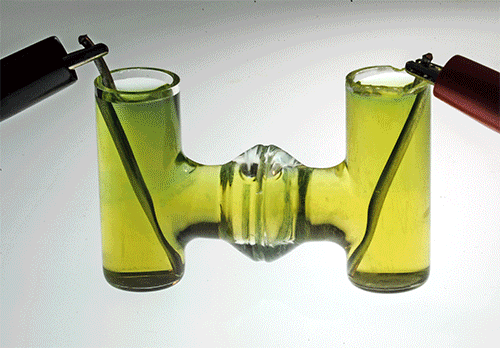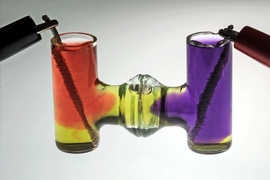It’s well known that the production of cement — the world’s leading construction material — is a major source of greenhouse gas emissions, accounting for about 8 percent of all such releases. If cement production were a country, it would be the world’s third-largest emitter.
A team of researchers at MIT has come up with a new way of manufacturing the material that could eliminate these emissions altogether, and could even make some other useful products in the process.
The findings are being reported today in the journal PNAS in a paper by Yet-Ming Chiang, the Kyocera Professor of Materials Science and Engineering at MIT, with postdoc Leah Ellis, graduate student Andres Badel, and others.
“About 1 kilogram of carbon dioxide is released for every kilogram of cement made today,” Chiang says. That adds up to 3 to 4 gigatons (billions of tons) of cement, and of carbon dioxide emissions, produced annually today, and that amount is projected to grow. The number of buildings worldwide is expected to double by 2060, which is equivalent to “building one new New York City every 30 days,” he says. And the commodity is now very cheap to produce: It costs only about 13 cents per kilogram, which he says makes it cheaper than bottled water.
So it’s a real challenge to find ways of reducing the material’s carbon emissions without making it too expensive. Chiang and his team have spent the last year searching for alternative approaches, and hit on the idea of using an electrochemical process to replace the current fossil-fuel-dependent system.
Ordinary Portland cement, the most widely used standard variety, is made by grinding up limestone and then cooking it with sand and clay at high heat, which is produced by burning coal. The process produces carbon dioxide in two different ways: from the burning of the coal, and from gases released from the limestone during the heating. Each of these produces roughly equal contributions to the total emissions. The new process would eliminate or drastically reduce both sources, Chiang says. Though they have demonstrated the basic electrochemical process in the lab, the process will require more work to scale up to industrial scale.
First of all, the new approach could eliminate the use of fossil fuels for the heating process, substituting electricity generated from clean, renewable sources. “In many geographies renewable electricity is the lowest-cost electricity we have today, and its cost is still dropping,” Chiang says. In addition, the new process produces the same cement product. The team realized that trying to gain acceptance for a new type of cement — something that many research groups have pursued in different ways — would be an uphill battle, considering how widely used the material is around the world and how reluctant builders can be to try new, relatively untested materials.
The new process centers on the use of an electrolyzer, something that many people have encountered as part of high school chemistry classes, where a battery is hooked up to two electrodes in a glass of water, producing bubbles of oxygen from one electrode and bubbles of hydrogen from the other as the electricity splits the water molecules into their constituent atoms. Importantly, the electrolyzer’s oxygen-evolving electrode produces acid, while the hydrogen-evolving electrode produces a base.
In the new process, the pulverized limestone is dissolved in the acid at one electrode and high-purity carbon dioxide is released, while calcium hydroxide, generally known as lime, precipitates out as a solid at the other. The calcium hydroxide can then be processed in another step to produce the cement, which is mostly calcium silicate.
The carbon dioxide, in the form of a pure, concentrated stream, can then be easily sequestered, harnessed to produce value-added products such as a liquid fuel to replace gasoline, or used for applications such as oil recovery or even in carbonated beverages and dry ice. The result is that no carbon dioxide is released to the environment from the entire process, Chiang says. By contrast, the carbon dioxide emitted from conventional cement plants is highly contaminated with nitrogen oxides, sulfur oxides, carbon monoxide and other material that make it impractical to “scrub” to make the carbon dioxide usable.
Calculations show that the hydrogen and oxygen also emitted in the process could be recombined, for example in a fuel cell, or burned to produce enough energy to fuel the whole rest of the process, Ellis says, producing nothing but water vapor.

In a demonstration of the basic chemical reactions used in the new process, electrolysis takes place in neutral water. Dyes show how acid (pink) and base (purple) are produced at the positive and negative electrodes. A variation of this process can be used to convert calcium carbonate (CaCO3) into calcium hydroxide (Ca(OH)2), which can then be used to make Portland cement without producing any greenhouse gas emissions. Cement production currently causes 8 percent of global carbon emissions.
In their laboratory demonstration, the team carried out the key electrochemical steps required, producing lime from the calcium carbonate, but on a small scale. The process looks a bit like shaking a snow-globe, as it produces a flurry of suspended white particles inside the glass container as the lime precipitates out of the solution.
While the technology is simple and could, in principle, be easily scaled up, a typical cement plant today produces about 700,000 tons of the material per year. “How do you penetrate an industry like that and get a foot in the door?” asks Ellis, the paper’s lead author. One approach, she says, is to try to replace just one part of the process at a time, rather than the whole system at once, and “in a stepwise fashion” gradually add other parts.
The initial proposed system the team came up with is “not because we necessarily think we have the exact strategy” for the best possible approach, Chiang says, “but to get people in the electrochemical sector to start thinking more about this,” and come up with new ideas. “It’s an important first step, but not yet a fully developed solution.”
The research was partly supported by the Skolkovo Institute of Science and Technology.












